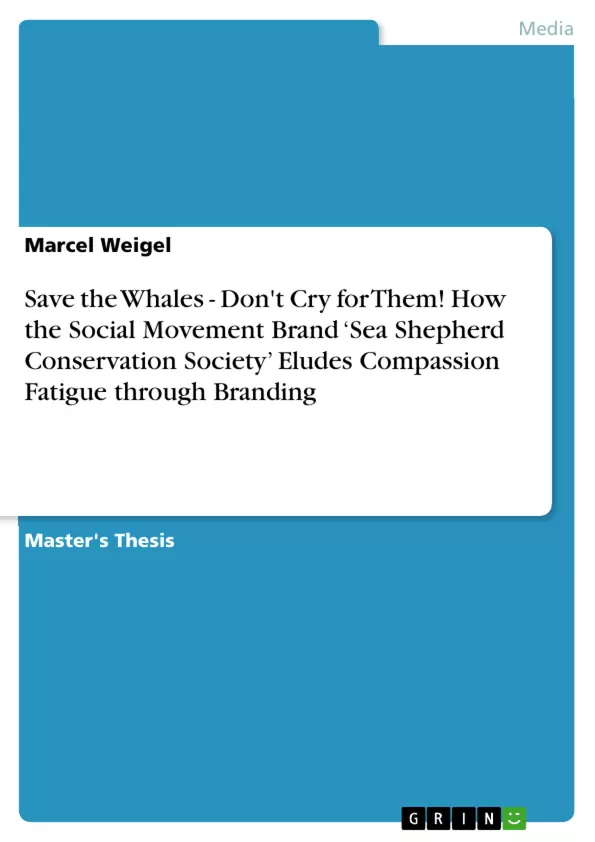The rising influence of neoliberalism in western societies led to a marketization of seemingly non-economic spheres of life. As a result, boundaries between non-profit organisations and state duties on the one hand and economics on the other hand have been blurring.
At the same time, charitable organisations have been facing the problem of Compassion Fatigue and the need of new donor approaches to support their causes. Both challenges are in some extent interrelated with each other and can be dealt with by the use of brand logic.
The aim of this thesis is to analyse how non-profit non-governmental organisation (NPNGOs) perform in a marketised world using their reputation as core of their brand creation. The new requirements NPNGOs have to meet in order to succeed in a marketised environment are worked out theoretically and applied to the example of the radical environment protection organisation Sea Shepherd. Its communication strategies and brand creation are examined through the concepts of Branding and Reputation Management which are used as related theoretical frameworks.
The analysis of Sea Shepherd in terms of the theoretical frameworks, finally, provides an insightful example of how NPNGOs nowadays can act like brands. In a marketised world in which audiences are used to interact with and to project themselves into brands which meet their values, also NPNGOs have to play the game of the marketplace. Sea Shepherd’s YouTube communication, its online shop along with its merchandise production, its official website and finally, its use of the logo, are vital illustrations of NPNGOs’ Branding.
Inhaltsverzeichnis (Table of Contents)
- A. Introductory Section
- 1. Introduction
- 2. Motivation of the thesis
- 3. Academic Approaches to Social Movement Branding
- 4. Research Aim and Questions
- B. Contextual Framework
- 5. Disambiguation: Non-Profit Non-Governmental Organisations
- 6. Communicating and Performing in Neoliberal Environments
- 6.1 Living in a Marketised World
- 6.2 A Networked Society - Communication via New Media
- 6.3 The Branding of Everything
- 7. Altered Requirements – NPNGOs facing the Neoliberal Reality
- 7.1 Presenting Suffering is so 1990's - The Danger of Compassion Fatigue
- 7.2 Changing Donors' Generations - Changing Communication?
- C. Theories
- 8. How to Sell the Good Conscience?
- 8.1 Branding - the Universal Marketing Weapon?
- 8.2 Reputation Management - Branding 2.0
- 8.3 The communicative Social Movement Brand
- 8.3.1 Why Social Movement Brands
- 8.3.2 How to Manage a Social Movement Brand
- 8. How to Sell the Good Conscience?
- D. Material and Methods
- 9. The Information Ocean of Sea Shepherd
- 9.1 Conservation Pirates
- 9.2 Sea Shepherd in the Online World
- 9.2.1 Sea Shepherd on YouTube
- 9.2.2 Sea Shepherd's Home Port - The Website
- 9.2.3 Sea Shepherd's Online Shop
- 9. The Information Ocean of Sea Shepherd
- E. Analysis Section
- 10. How Sea Shepherd Communicates via the Internet
- 10.1 YouTube: Blockbuster Pirates
- 10.2 Official Website
- 10.2.1 Structural Analysis
- 10.2.2 Content Analysis
- 10.3 Official Online Shop
- 10.3.1 Structural Analysis
- 10.3.2 Content Analysis
- 10.4 Sea Shepherd's logos
- 10. How Sea Shepherd Communicates via the Internet
- F. Discussion and Conclusion
- 11. Selling the Image
- 11.1 Sea Shepherd's Merchandise
- 11.2 Sea Shepherd's Business Co-operations
- 12. Sea Shepherd and Compassion Fatigue
- 13. Sea Shepherd's Reputation Management as Branding Effort
- 11. Selling the Image
Zielsetzung und Themenschwerpunkte (Objectives and Key Themes)
This thesis examines how non-profit non-governmental organisations (NPNGOs) operate in a marketised world, focusing on the use of branding to build their reputation. It explores the challenges faced by NPNGOs in a neoliberal environment, particularly the issues of Compassion Fatigue and changing donor demographics. The thesis investigates the branding strategies employed by Sea Shepherd Conservation Society, a radical environmental protection organisation, as an exemplary case study. The research aims to understand how Sea Shepherd effectively leverages its brand to connect with audiences and address these challenges.
- Branding and Reputation Management in the context of NPNGOs
- Compassion Fatigue and its implications for social movement organisations
- The impact of neoliberalism and marketization on NPNGO communication
- Sea Shepherd's strategic use of branding for social change
- The role of new media and online platforms in NPNGO branding
Zusammenfassung der Kapitel (Chapter Summaries)
The thesis begins by introducing the concept of social movement branding and outlining the motivation and research questions guiding the study. It then provides a contextual framework, explaining the disambiguation of NPNGOs and exploring the influence of neoliberalism on their communication practices. The discussion focuses on the challenges posed by Compassion Fatigue and the changing demographics of donors. Subsequently, the thesis delves into theoretical frameworks of branding and reputation management, exploring their application to social movement organisations. The study then examines Sea Shepherd's online communication, focusing on its YouTube presence, website, online shop, and logo use. Finally, the thesis analyzes Sea Shepherd's efforts in combating Compassion Fatigue and leveraging reputation management for branding purposes.
Schlüsselwörter (Keywords)
The key terms and concepts explored in this thesis include branding, conservation, Compassion Fatigue, marketization, neoliberalism, NGO, non-profit, Paul Watson, Reputation Management, Sea Shepherd, social movements. These terms represent the central focus areas of the study, highlighting the interplay between social movements, branding strategies, and the impact of neoliberalism on environmental conservation organizations.
- Quote paper
- Marcel Weigel (Author), 2015, Save the Whales - Don't Cry for Them! How the Social Movement Brand ‘Sea Shepherd Conservation Society’ Eludes Compassion Fatigue through Branding, Munich, GRIN Verlag, https://www.grin.com/document/312947



